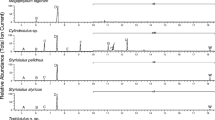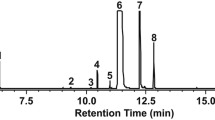Abstract
Centipedes of the order Geophilomorpha produce a viscid odorous secretion that is effectively defensive against ants (Formica exsectoides). The secretion is proteinaceous and cyanogenetic. InGeophilus vittatus, the secretion contains two cyanogenetic compounds, mandelonitrile (I) and benzoyl cyanide (II), as well as two products derived from these compounds as a result of hydrogen cyanide production [benzaldehyde (III) and benzoic acid (IV)]. Benzoyl cyanide has not been reported previously from any natural source.
Similar content being viewed by others
References
Attems, C.G. 1926. Chilopoda. Pages 239–402,in W. V. Kükenthal and T. Krumbach (eds.),Handbuch der Zoologie, Vol. 4, Walter de Gruyter and Co., Berlin.
Barbetta, M., Casnati, G., andPavan, M. 1966. Sulla presenza di D-(+)-mandelonitrile nella secrezione difensiva del miriapodeGomphodesmus pavani Dem.Mem. Soc. Entomol. Ital. 45:169–176.
Brade-Birks, H.K., andBrade-Birks, S.G. 1920. Note on Myriapoda. XX. Luminous Chilopoda, with special reference toGeophilus carpophagus, Leach.Ann. Mag. Nat. Hist. Ser. 9(5):1–30.
Crabill, R.E. 1952.The centipedes of northeastern North America. Ph.D. thesis, Cornell University, Ithaca, New York. 450 pp.
Eisner, H.E., Alsop, D.W., andEisner, T. 1967. Defense mechanisms of arthropods. XX. Quantitative assessment of hydrogen cyanide production in two species of millipedes.Psyche 74:107–117.
Eisner, T., Eisner, H.E., Hurst, J.J., Kafatos, F.C., andMeinwald, J. 1963. Cyanogenic glandular apparatus of a millipede.Science 139:1218–1220.
Feigl, F. 1966.Spot tests in organic analysis. Elsevier, New York. 772 pp.
Koch, A. 1927. Studien an leuchtenden Tieren. I. Das Leuchten der Myriapoden.Z. Morphol. Ökol. Tiere 8:241–270.
Moore, B.P. 1967. Hydrogen cyanide in the defensive secretions of larval Paropsini (Coleptera: Chrysomelidae).J. Aust. Entomol. Soc. 6:36–38.
Murthy, M.R.V., andLeroux, T. 1975. Determination of protein in extracts containing interfering substances and in radioactive samples following scintillation counting.Anal. Biochem. 64:18–29.
Oakwood, T.S., andWeisgerber, C.A. 1965. Pages 112–114,in Organic syntheses, collected, Vol. 3, E.C. Horning, (ed.), John Wiley, New York.
Schildknecht, H., Maschwitz, U., andKrauss, D. 1968. Blausäure im Wehrsekret des ErdläufersPachymerium ferrugineum.Naturwissenschaftern 55:230.
Towers, G.H.N., Duffey, S.S., andSiegel, S.M. 1972. Defensive secretion: Biosynthesis of hydrogen cyanide and benzaldehyde from phenylalanine by a millipede.Can. J. Zool. 50:1047–1050.
Author information
Authors and Affiliations
Additional information
This is Paper No. 48 in the seriesDefense Mechanisms of Arthropods.
Rights and permissions
About this article
Cite this article
Jones, T.H., Conner, W.E., Meinwald, J. et al. Benzoyl cyanide and mandelonitrile in the cyanogenetic secretion of a centipede. J Chem Ecol 2, 421–429 (1976). https://doi.org/10.1007/BF00988807
Received:
Revised:
Issue Date:
DOI: https://doi.org/10.1007/BF00988807




